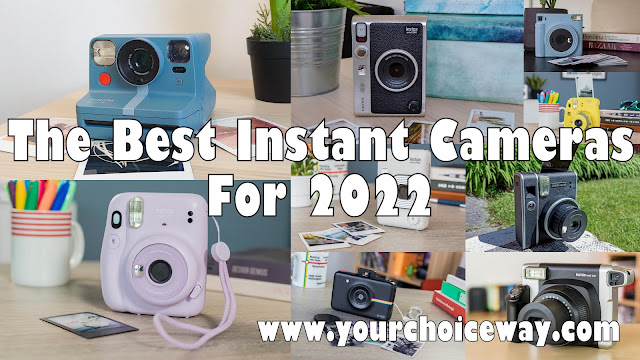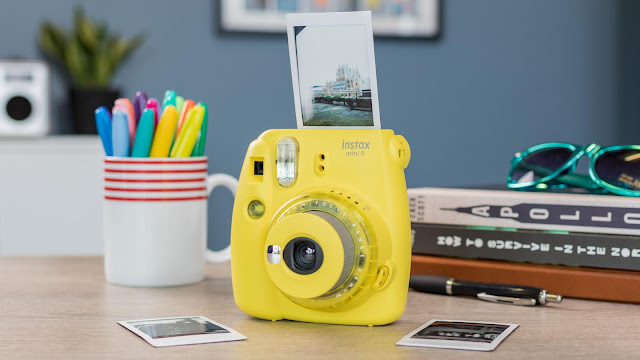Instant cameras may have been all the rage in the 1970s, but they’re still popular right now – and are a great unique gift.
Not only can you once again buy a new Polaroid camera, but Fujifilm’s Instax has become a global phenomenon, and other companies like Leica and Lomography have gotten in on the action too.
Some instant cameras even now pack digital tech too, allowing you to do things like take multiple shots before picking which to print, save digital copies of photos for your Instagram, or even print shots straight from your phone. Thanks to connected apps, others even offer interactive games and the chance to tweak your prints with stickers, filters, or QR codes to access videos and the like.
The downside is that there are now multiple competing film formats, sizes, and brands, and it’s hard to know which instant camera is right for you. Luckily for you we’ve tested almost every camera on the market, and here’s what we think.
1. Instax Mini 11
- Affordable
- Easy to use
- Range of colours
Cons
- Toy-like design
- Too simple for some
The Instax Mini 11 offers good low-light exposure, a sleek design and easy-to-use controls – all for a reasonable price.
The auto-exposure dial makes low light photography reasonably visible, and the design is slimmer and more refined than its predecessor overall. There aren’t any manual adjustments that users can make to the camera, but at this price point that’s to be expected.
The Mini 11 prints on Instax’s Mini film – which produces pocket-sized polaroid-style photos. This instant camera is a compelling option for younger audiences with not much photography experience.
Read our full Instax Mini 11 review
2. Instax Mini Evo
- Compact retro design
- Long battery life
- Great physical controls
Cons
- Expensive
- Limited storage
The Instax Mini Evo from Fujifilm combines all the bells and whistles of a classic digital camera with the novelty of an instant camera.
But you don’t just have to print snaps taken on the Evo – it can also connect to your phone and print photos, just like a standard portable printer.
Combining the digital camera features with analogue buttons results in a fun shooting experience, and the fact that it doubles as an instant printer is the icing on the cake.
It looks more professional than cheaper Instax models, with a retro-inspired design. That said, be prepared to spend a pretty penny to get your hands on one.
Read our full Instax Mini Evo review
3. Instax Square SQ1
- Classic square format
- Simple to use
- Great design
Cons
- Chunky
- More expensive film
The Instax SQ1 is Fujifilm’s second fully analogue square format camera, and it’s a simplified version of the old SQ6, which is now hard to find in stock.
The SQ1 takes Instax Square film, which in turn means this is a bigger, chunkier camera than the Instax Minis. It comes in a similar range of attractive pastel colours though, and there’s a definite charm to the camera’s look.
This is another Instax that’s designed to be as simple to use as possible. There are only two shooting modes – regular, and a selfie/macro mode you access by twisting the lens round. You can’t even turn the flash off.
We wish it had a few more options to be honest, especially given its price, but if you want an easy-to-use Instax that shoots on square film, this is your best bet.
Read our full Instax Square SQ1 review
4. Instax Mini LiPlay
- Prints digital photos
- Easy to use
Cons
- Divisive design
- Still Expensive
The Instax Mini LiPlay is a slightly cheaper precursor to the Mini Evo, above. We prefer the newer Evo, but the LiPlay is a great option if you can find it for less.
The camera is also an instant printer, which allows you to print photos directly from your smartphone via the companion app very easily on to the Instax Mini film.
It’s also generally an easy camera to navigate. The design is user-friendly, and you can choose from a number of different shooting options to enhance your experience. The camera itself is enough to give you a decent-quality image, with a little flair if you wish. However, the design may not be to everyone’s tastes.
The Mini LiPlay lets you record audio and play it back via QR codes, though this feature may only be useful to a small portion of users. It sits just slightly higher than average on our price range, but the flexibility that this camera offers seems worth the extra bump in cost.
Read our full Instax Mini LiPlay review
5. Instax Mini 40
- Retro aesthetic
- Easy to use
Cons
- Pricier than Mini 11
- No advanced options
Even by the standards of instant cameras, this is driven by nostalgia. The blocky plastic design screams ‘retro’, accentuated by the textured faux-leather finish and silver accents.
As the name suggests, the Mini 40 takes Instax Mini format prints, and in fact this is essentially the same camera as the Mini 11 above – the functionality is almost identical, with the higher price driven by the premium, retro design.
That means simple features: a flash, a selfie mirror, and two focal length settings. You don’t get a lot of flexibility, but the simplicity is welcome when you just want to point and shoot.
If you’re not fussed on the design then save money and grab the Mini 11, but if you want an Instax Mini camera that feels like a camera, not a toy, then this is the one.
Read our full Instax Mini 40 review
6. Polaroid Now+
- Retro design
- Tripod mountable
- Included accessories
Cons
- Big and bulky
- Expensive
The Polaroid Now+ is our favourite of the company’s range of modern instant film cameras – especially if you know how to use it.
With a range of shooting options, supported by an app that enables remote controls and other modes, this is more complicated than some of the simple point-and-shoot cameras from Instax. That will appeal to capable photographers, but might put you off if you want something more straightforward.
Like other Polaroid cameras it is big and bulky, and the film runs fairly expensive – but that’s the price you pay (literally) for getting the classic Polaroid camera design and iconic large format square prints, which obviously up the appeal.
Read our full Polaroid Now+ review
7. Instax Mini 9
- Cheap
- Colourful
- Simple
- No auto-exposure
- Mini 11 is better
The Instax Mini 9 from Fujifilm is the cheapest instant camera out there. The Mini 9 is very user-friendly, making it a good option for any photography beginners – or kids. Its design is chunky and retro, coming in a range of colours.
The Mini 9 takes Instax Mini film, but shooting capabilities are limited. It relies on bright daylight, and doesn’t have any zoom capabilities, nor the option to turn off the flash. The camera does however come with some manual lenses that you can attach for things such as close-up shots.
It may not stack up to some of its rivals when it comes to its technical requirements, but if you’re looking for a stocking filler that takes nice Polaroid-style photos, then this is by far the most affordable option at the moment.
Read our full Instax Mini 9 review
8. Polaroid Snap
- Cheap prints
- microSD support
- Prints digital photos
Cons
- Worse quality
- Limited controls
The Polaroid Snap captures the happy middle ground between quality and budget. For less than £100/US$100, you get a likeable 10Mp camera which supports microSD saving, and prints colour photos within a minute – though it’s worth noting that this is a digital camera that prints onto ZINK paper, rather than an analogue camera that exposes real film.
Unlike the film used in an Instax Mini 9 camera, ZINK paper uses heat to form images. Each sheet contains micro-crystals that produce either cyan, magenta or yellow hues depending on the intensity and duration of heat applied. When combined, you are left with the final image. This makes printing on the Snap more affordable too.
The colours on Polaroid Snap prints are on the darker side, so it is best for photographing under bright to moderate lighting (though the Snap does have an automatic flash). The Snap is a budget-friendly tech toy best suited for casual point and shoot use, making it ideal for students and scrapbook keepers.
Read our full Polaroid Snap review
9. Instax Wide 300
- Large prints
- Great for landscapes
- Easy to use
Cons
- Big & heavy
- Ugly design
As the name might give away, the Instax Wide 300 takes photos that are wider than other instant cameras – double the size of Instax Mini photos. The camera itself has to be large enough to accommodate the bigger prints, and Fujifilm has committed to a chunky aesthetic all round, with a large grip and an enormous lens – the Instax Wide isn’t the most attractive instant camera around.
Controls are simple: two levels of autofocus for the 95mm lens, basic flash settings, and the option to reduce or increase exposure. It’s no surprise the Wide 300 excels at longer range, picking up more detail in landscape and building photos than its rivals, but struggling on close-ups or selfies – though the included close-up lens does help.
Portraits can turn out great once you get used to framing for landscape though, with warm skin tones. The new orientation is also great for parties – it takes a lot less work to cram multiple people into the same shot now.
Read our full Instax Wide 300 review












0 comments:
Post a Comment